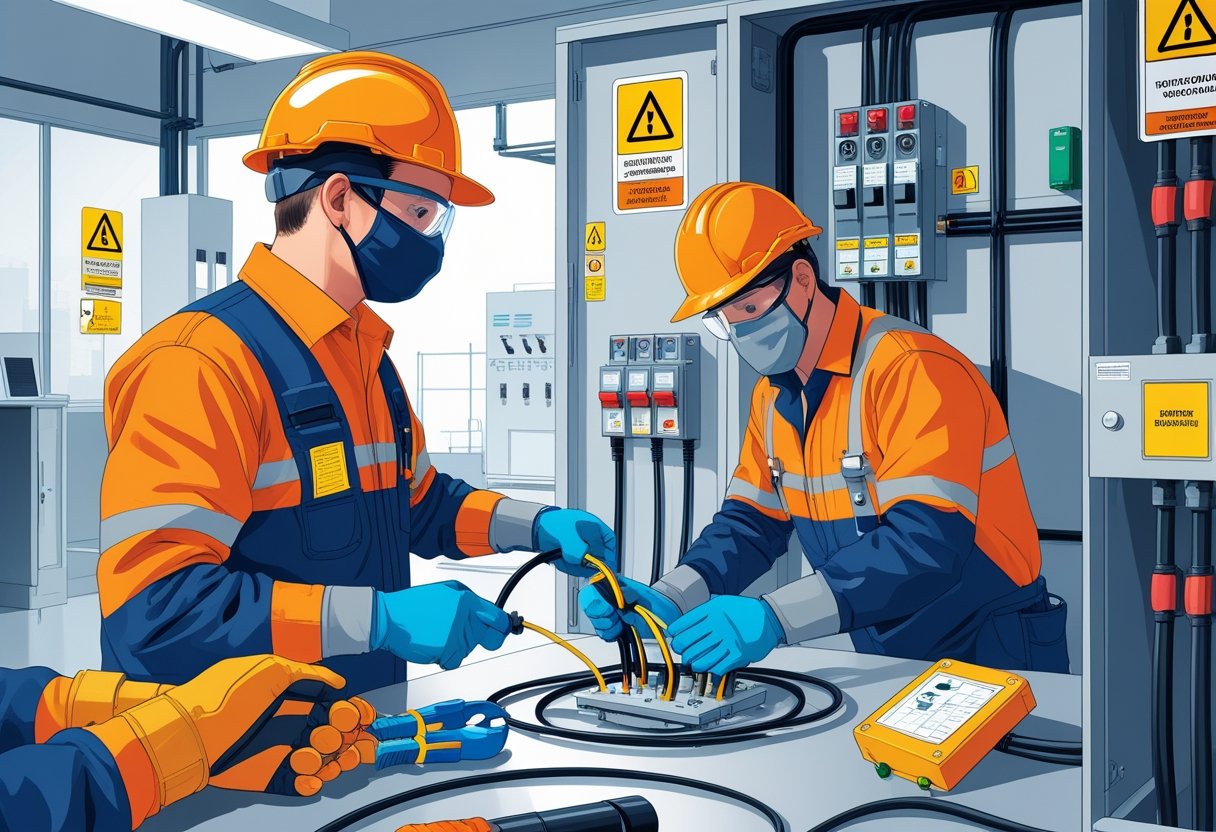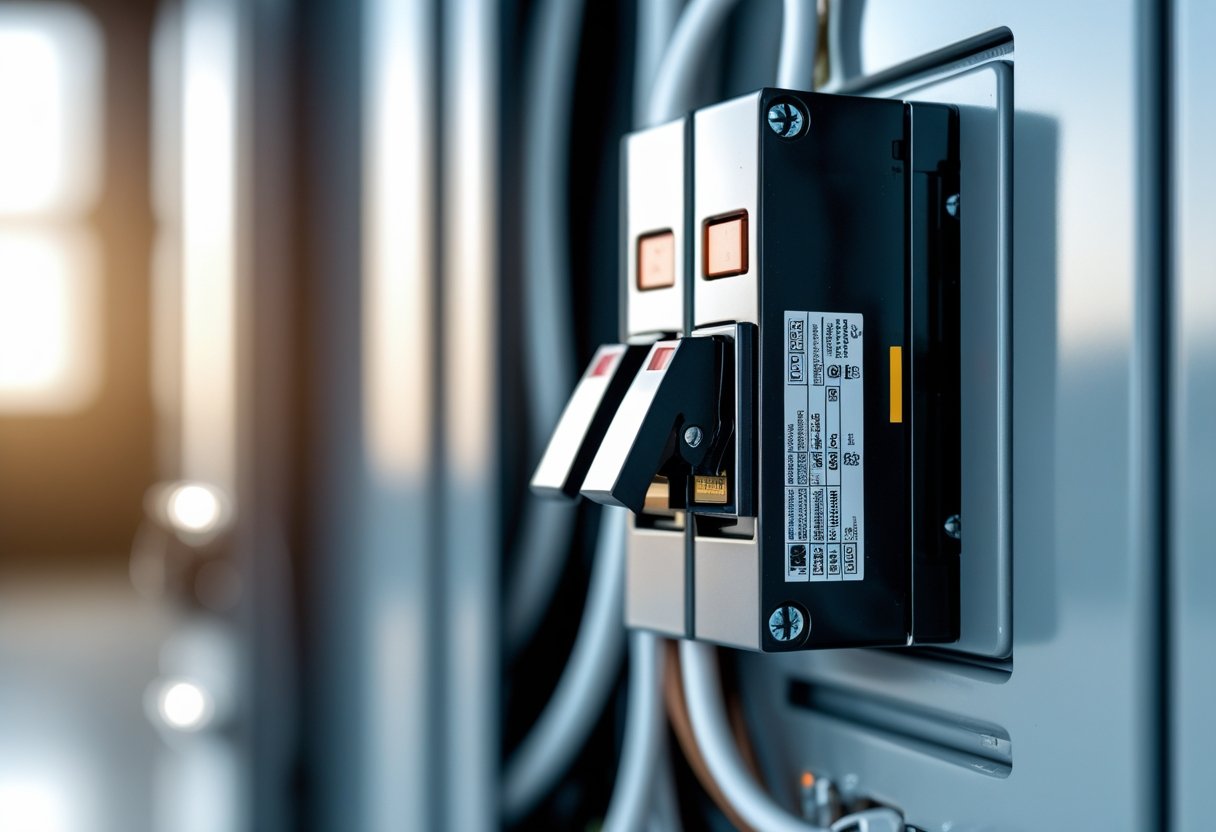Electrical safety in the workplace is a crucial aspect that every business must prioritize. Every year, electrical hazards lead to numerous injuries and fatalities, making it essential for employers and employees alike to understand the risks involved and the precautions to take. By implementing proper electrical safety practices, you can significantly reduce the likelihood of workplace accidents and ensure a safer environment for everyone.
At AAA Electrical Services, we emphasize a family-safety-first approach in every project. Whether it's ensuring the safe installation of circuit breakers or conducting thorough electrical inspections, our team is dedicated to protecting your home and ensuring peace of mind. With over 42 years of experience serving the Sacramento area, our licensed and certified technicians are equipped to handle any electrical task with transparency and professionalism.
Taking the time to educate yourself and your employees on electrical safety can make all the difference. Familiarizing yourself with safety protocols not only helps in compliance with regulations but also enhances the overall well-being of your workplace. Investing in electrical safety is investing in your team’s health and your business's success.
Understanding Electrical Hazards in the Workplace
Electrical hazards are a critical concern in any workplace, as they can lead to severe injuries and fatalities. Understanding the types of electrical hazards, their causes, and the potential impacts is essential for ensuring safety.
Types of Electrical Hazards
Different types of electrical hazards can exist in the workplace. Electric shock occurs when an electrical current passes through the body, potentially causing injury or death. Electrocution is a more severe form of electric shock, often resulting in fatality.
Another significant hazard is arc flash, which can produce intense heat and light, leading to burns and fires. An arc blast may also occur, causing explosive impacts that can injure employees. Understanding these hazards is key to implementing safety measures to prevent accidents.
Common Causes of Electrical Injuries
Electrical injuries commonly result from several factors. Faulty wiring or equipment often leads to hazardous situations, such as short circuits. Inadequate training is another common cause; employees who lack proper electrical safety training may not recognize dangers or safe operating procedures.
Environmental conditions, such as wet surfaces or cluttered work areas, can also increase the risk of accidents. Additionally, improper use of tools, without personal protective equipment (PPE), contributes significantly to the likelihood of electrical injuries.
Impact of Electrical Accidents
The impact of electrical accidents in the workplace can be devastating. Injuries can range from minor burns to serious electric shock, leading to permanent disability or death. High electrical fatalities statistics underscore the need for vigilance in safety practices.
Beyond physical injuries, electrical accidents can disrupt operations, resulting in financial losses for businesses. The potential for fires due to electrical faults can damage property and affect lives. Engaging a reliable service provider like AAA Electrical Services can help mitigate these risks through thorough inspections and robust safety protocols.
Essential Electrical Safety Practices
Electrical safety in the workplace is crucial for preventing accidents and ensuring a secure environment. Adopting safe work practices, recognizing hazards, and adhering to regulations are key components of maintaining electrical safety.
Safe Work Practices
Implementing safe work practices is foundational to electrical safety. Always use personal protective equipment (PPE), such as insulated gloves and safety goggles, when handling electrical components. Make sure to de-energize circuits before working on them and use voltage testers to confirm that no electricity is present.
Keep work areas tidy to prevent trips, falls, and other injuries. Ensure that all tools and equipment are in good working condition and suitable for the task at hand. Regularly review safety protocols with your team and conduct training sessions to ensure everyone understands the best practices. AAA Electrical Services emphasizes these safe work habits, tailored with your family’s safety in mind.
Hazard Recognition and Risk Assessment
Effective hazard recognition is essential for minimizing electrical risks. You should be aware of areas where electrical systems could fail, such as frayed wiring or overloaded circuits. Regular inspections can help detect these hazards early.
Conduct a risk assessment before beginning any electrical work. Identify potential dangers, including shock risks and fire hazards from faulty equipment. Use resources like the OSHA electrical safety guidelines to assist in your assessments. By being proactive and staying informed about risks, you can better protect yourself and your coworkers from electrical incidents.
Electrical Safety Rules and Regulations
Understanding and following electrical safety rules and regulations is vital for compliance and safety. The National Fire Protection Association's NFPA 70E outlines standards for electrical safety in the workplace, including proper maintenance, equipment handling, and employee training.
Make sure to familiarize yourself with relevant local codes and OSHA requirements. These regulations set the groundwork for safe electrical practices. Adhering to these guidelines not only enhances safety but also increases operational efficiency. Having a trusted service provider like AAA Electrical Services can help ensure that your workplace follows these essential standards.
Personal Protective Equipment and Safe Tools
Electrical safety in the workplace relies heavily on the proper use of Personal Protective Equipment (PPE) and safe tools. Understanding these elements is crucial for minimizing risks associated with electrical work.
Personal Protective Equipment (PPE) Requirements
To safeguard against electrical hazards, using the right PPE is essential. Electrical PPE includes items like insulated gloves, safety glasses, and flame-resistant clothing.
- Insulated Gloves: These are crucial for protecting your hands from electrical shocks. Ensure they are rated for the voltage you might encounter.
- Safety Glasses: Protect your eyes from flying debris and electrical arcs. Always choose ANSI-rated eyewear.
- Protective Clothing: Wear flame-resistant garments to shield your body from heat and burns.
Always inspect your PPE before use and replace any damaged items. At AAA Electrical Services, technicians are trained to prioritize safety by wearing full PPE during every job.
Use of Insulated and Conductive Tools
Using the correct tools can significantly impact safety during electrical work. Insulated tools are designed to prevent electrical shocks and are necessary when working on live circuits.
- Insulated Tools: These tools have a non-conductive covering that protects you during electrical tasks. Choose those rated for proper voltage levels.
- Conductive Tools: While necessary for certain tasks like testing, they should only be used on de-energized circuits. Always follow safety protocols when handling them.
Having the right tools minimizes risk and ensures efficient work. Our technicians carry a "warehouse on wheels," ensuring they have the right tools for fast, effective service.
Safe Distance and Guarding
Maintaining a safe distance from electrical hazards is key to accident prevention. Implementing proper guarding can help protect you from accidental contact.
- Safe Distance: Establish boundaries when working near energized equipment. Keep a safe distance according to the National Electrical Code (NEC) guidelines, which typically recommend a minimum distance varying by voltage type.
- Guarding: Use barriers or grounding techniques to prevent accidental contact with live components.
At AAA Electrical Services, we emphasize establishing clear safety zones and barriers as part of our commitment to family safety. By adhering to these practices, you enhance safety while conducting electrical work.
Electrical Equipment and System Safety
Ensuring the safety of electrical equipment and systems is crucial for preventing hazards in the workplace. Proper maintenance, awareness of exposed wiring, and effective management of cords are key components for safeguarding against electrical accidents.
Maintaining Electrical Equipment and Systems
Regular maintenance of your electrical equipment is essential. Inspections should be conducted frequently to identify wear and tear, especially around switchboards and junction boxes.
Replace any damaged electrical cords or fixtures promptly to avoid potential dangers, such as flickering lights, which could indicate underlying issues. Always ensure that your equipment is compliant with established safety standards.
Utilizing professional services, like those from AAA Electrical Services, ensures your systems are thoroughly maintained. Technicians are equipped to handle electrical repairs, making your workplace safer.
Identifying and Handling Exposed Wiring
Exposed wiring poses serious risks, including shock and fire hazards. Always be vigilant in identifying any electrical wires that are damaged or frayed. If you come across exposed wiring, it is crucial to avoid handling it yourself.
Instead, contact a licensed technician to manage the situation safely. Use insulation and proper barriers to restrict access to hazardous areas. Regular training on recognizing and reporting these hazards can empower employees to maintain a safer environment.
Managing Extension and Flexible Cords
Extension cords and flexible cords should be used correctly to prevent accidents. Inspect these cords regularly for any signs of damage, such as cuts or frays. When using extension cords, ensure they are suitable for the intended load to avoid overheating.
Secure cords to prevent tripping hazards, and never daisy-chain multiple cords together. If you need reliable electrical installation or upgrades, AAA Electrical Services can help with safe solutions for your workplace's power needs. Remember, effective management of cords enhances workplace safety significantly.
Controlling Electrical Hazards: Lockout/Tagout and Grounding
Implementing effective control measures for electrical hazards is essential for maintaining a safe workplace. Two critical methods are Lockout/Tagout (LOTO) procedures and proper grounding techniques, which help prevent accidents associated with energized equipment.
Lockout/Tagout (LOTO) Procedures
Lockout/Tagout (LOTO) procedures are essential for safeguarding employees during maintenance or repair work on electrical systems. They ensure that all energy sources are effectively isolated, preventing accidental energization.
- Identify the energy sources associated with the equipment.
- Notify affected employees before implementing LOTO.
- Shutdown the equipment and isolate the energy sources.
- Apply lockout devices to secure energy isolating devices, ensuring they cannot be re-energized.
- Attach tagout devices to warn others not to operate the equipment.
These steps help ensure a safe working environment, significantly reducing the risk of shock or injury. You can learn more about these guidelines through OSHA's LOTO regulations.
Proper Grounding and Bonding
Grounding is a crucial safety measure that directs any stray electrical current safely into the ground. This prevents equipment from becoming energized unintentionally. Proper bonding connects various electrical components to create a continuous path for fault currents.
- Grounding electrodes must be installed in accordance with local codes.
- Ensure all equipment is correctly bonded to prevent differences in voltage that can pose risks.
Regular inspections of grounding systems help maintain their integrity, particularly in facilities handling large electrical loads. This proactive approach minimizes the chances of electrical faults leading to accidents.
Working with Energized Equipment
When working with energized equipment, safety protocols are paramount. Always assess the risks involved and wear appropriate personal protective equipment (PPE).
- Use appropriate lockout/tagout procedures if possible to de-energize equipment.
- If de-energizing is not feasible, implement equipotential zone grounding to reduce hazards.
- Ensure that your work area is clear of unnecessary personnel and that everyone is trained on emergency procedures.
By taking these precautions, you prioritize your safety and the safety of those around you. AAA Electrical Services emphasizes safe practices tailored to your family’s needs, ensuring electrical work is conducted with utmost care and professionalism.
Preventing Electrical Incidents and Responding to Emergencies
Electrical safety in the workplace is essential to prevent accidents and respond effectively when issues arise. By understanding potential hazards and establishing protocols, you can protect both personnel and property from electrical incidents.
Preventing Electrical Fires and Short Circuits
Electrical fires are often caused by faulty wiring, overloaded circuits, and equipment malfunction. To reduce risks, regularly inspect all electrical equipment for wear and tear. Ensure that your workplace adheres to safety standards and that wiring is done by qualified electricians.
Using circuit breakers and fuses effectively can help prevent short circuits. Consider these measures:
- Avoid overloading circuits: Distribute electrical loads evenly.
- Use surge protectors: Protect equipment from voltage spikes.
- Install smoke alarms: Ensure they are operational and tested regularly.
When you see warning signs like flickering lights or burning smells, address them immediately. For tailored solutions, consult with experts like AAA Electrical Services, known for their commitment to safety.
Safe Use of GFCIs and Power Lines
Ground Fault Circuit Interrupters (GFCIs) are crucial in areas susceptible to water exposure, such as kitchens and bathrooms. These devices can prevent electrical shock by shutting off power when a fault is detected.
To ensure their effectiveness, regularly test GFCIs by pressing the “test” button. If they fail to trip, they need replacement.
When working near overhead power lines:
- Always maintain a safe distance, ideally at least 10 feet.
- Use spotters when operating large equipment.
- Be aware of weather conditions, as wet conditions increase the risk of accidents.
Following these guidelines helps maintain workplace safety while using electrical devices.
Emergency Response and Training
Having a thorough emergency response plan in place is essential. This plan should include detailed steps for various scenarios, including electrical shocks, fires, or equipment failures. Training is critical; ensure staff undergo regular electrical safety training.
Components of an effective response plan include:
- Immediate reporting procedures
- First aid protocols for electrical injuries
- Regular drills to reinforce response strategies
Conducting these practices will prepare you to handle emergencies effectively. Partnering with professionals, like AAA Electrical Services, can enhance your training programs and ensure compliance with safety standards.
Frequently Asked Questions
Electrical safety in the workplace is critical for protecting employees and minimizing risks. This section addresses common inquiries regarding guidelines, identifying hazards, responding to emergencies, and recommended training for safe electrical practices.
What are the recognized electrical safety guidelines that OSHA mandates for workplaces?
OSHA mandates several guidelines to ensure electrical safety. Key regulations include proper grounding, use of circuit protection devices, and maintaining safe distances from electrical sources. Employers must also ensure that all equipment is regularly inspected and that employees receive adequate training on electrical safety protocols.
How do you identify and mitigate electrical hazards in a work environment?
Begin by conducting a thorough inspection of the workspace to identify potential hazards. Look for frayed cords, outdated equipment, and wet areas. Mitigation can involve using protective equipment, labeling electrical panels, and conducting regular maintenance checks to eliminate risks.
What are the best practices for ensuring electrical safety in the workplace?
Best practices include implementing lockout/tagout procedures, ensuring all electrical equipment is properly maintained, and using insulated tools. Employees should be trained on safety protocols and encouraged to report any safety concerns promptly.
Can you outline the procedures for responding to an electrical emergency at work?
In an electrical emergency, first ensure that everyone is safe and away from the hazard. If safe, turn off the power at the circuit breaker. Call emergency services if there are injuries or significant hazards. Always have an action plan and ensure employees know how to respond effectively.
What training is recommended for employees to handle electrical equipment safely?
Employees should receive training on recognizing electrical hazards, safe use of equipment, and emergency response protocols. Regular refresher courses can help keep safety practices fresh in their minds.
What are the common electrical safety measures that need to be implemented in the workplace?
Common measures include ensuring proper grounding of electrical systems, using GFCI outlets in wet areas, and employing surge protection devices. Regular inspections and maintenance are vital to maintaining these safety measures.
For tailored electrical services designed with your family’s safety in mind, consider reaching out to AAA Electrical Services. With over 42 years of expertise, they offer reliable support for all your electrical needs.





